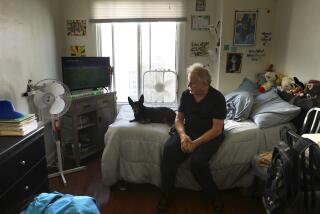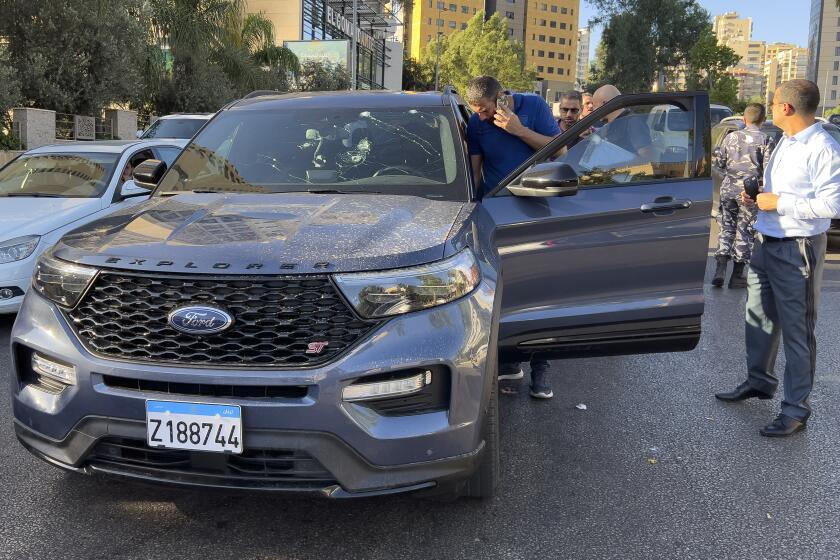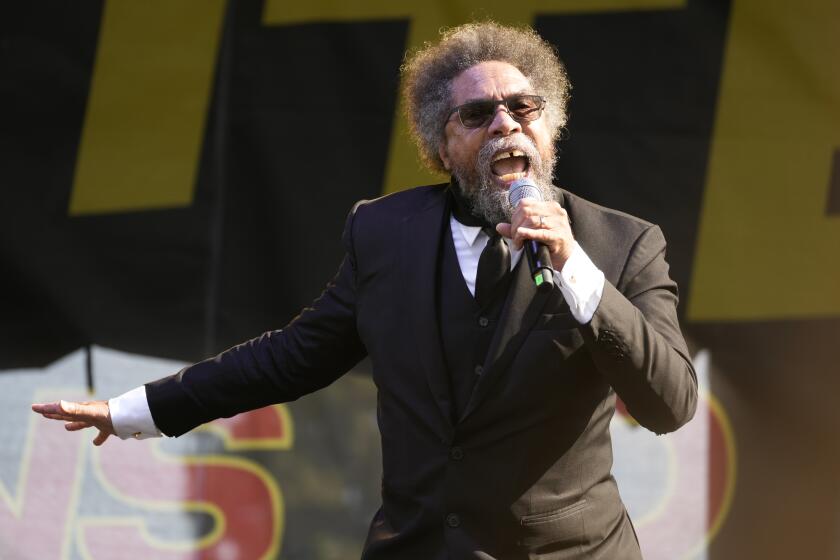Srebrenica’s Scars May Never Fade
In late afternoon, the three women rest on a tattered blanket, tired from chores that are now theirs alone to bear in this village without men.
They are survivors of the Srebrenica massacre that began July 11, 1995, when Bosnian Serb troops stormed the U.N.-declared “safe haven” and took away their husbands and fathers, brothers and sons. Over the next eight days in the nearby hills, the Serbs killed as many as 8,000 Muslim men and boys, the worst massacre in Europe since World War II.
“We could forgive them taking our property, if they didn’t also take our youth, our men, our lives,” said Hasrija Krdzic, 66, who lost her husband, two brothers and several nephews in the massacre and other wartime violence. She returned two years ago to Osmace, her native village, about a half-hour drive from Srebrenica.
Today, the only males in the village are a handful of teenagers and a couple of twentysomethings who were children when the carnage occurred. So it is mostly women who haul wood and cut it for kindling, hoe the subsistence gardens and herd cattle.
Only a few Muslims have moved back to the town of Srebrenica itself, even though many of those Serbs who had taken over Muslim homes have been forced by the government to vacate them. The two communities have separate bakeries, separate cafes; the Serbs still run most grocery stores. All in all it is a blighted place where the few people move like shadows, and Muslims and Serbs lead separate lives.
Nearly 10 years after the end of the war, Bosnia-Herzegovina remains a deeply troubled place: divided ethnically, dependent on international aid for its economic survival and ruled by a European viceroy who can impose legislation and fire Bosnian officials if they fail to integrate the Serb, Croat and Muslim populations.
The challenges facing the international community here carry important lessons for U.S. and British diplomats in Iraq who now confront a similar task of patching together a civil society and overcoming ethnic and religious fissures. The key lesson from Bosnia, a decade after the bloody conflict epitomized by Srebrenica, is that ethnic and religious hatreds, once violently unleashed, are difficult to bury.
There are similarities in the circumstances of the two countries. Both must find a way to share power among three ethnic and religious groups. In Bosnia, Muslims, Serbs and Croats contend for power; in Iraq, the struggle is among Kurds, Arab Sunni Muslims and Shiite Muslims.
In both, ethnic and religious animosities had been kept in check by a strongman, although former Iraqi President Saddam Hussein was far more brutal than his Yugoslav counterpart, Josip Broz Tito. Both countries have had foreign military intervention, and in both, Western powers have undertaken to rebuild the country and keep the peace.
But there are differences as well. In Bosnia, by the time the North Atlantic Treaty Organization sent troops, nearly 200,000 people had been killed in a three-way civil war. In Iraq, ethnic and religious conflict broke out after the U.S.-led invasion.
Another striking difference is the absence of violence in Bosnia after the end of the war in December 1995. Since then, not a single international peacekeeper has died as a result of hostile action, and ethnically motivated killings gradually have stopped.
The international military commanders in Bosnia went in “with literally overwhelming force,” High Representative Paddy Ashdown said, and the result is that “security matters rarely cross my desk.... We’re into the state-building phase.”
NATO commanders fielded 60,000 troops in Bosnia, a country with a population of barely more than 3.5 million people. For a comparable force in Iraq, more than 360,000 troops would had to have been deployed in May 2003, when President Bush declared that major combat had ended. Instead, little more than a third of that number was in the country. And although the U.S. has added troops, the numbers still fall well below the proportion in Bosnia.
Bosnia’s greatest achievement, on the surface at least, has been the effort to undo the displacement of nearly 2 million people in “ethnic cleansing.” Getting them to come home would have been impossible without security, which for most people meant the assurance that there would be no more killing.
In dozens of interviews with Serbs and Muslims, no one said they feared violence from their neighbors, but a closer look revealed a less sanguine picture.
It is mostly the elderly who have returned to their homes; younger people came only to rebuild their houses and sell them to whichever ethnic group is the local majority. The paucity of young people in the villages of Bosnia means that when the older generation of minority residents dies, the ethnic diversity of the area will die with them.
“There is manifestly less multi-ethnicity than there was before the war. Is there a long way to go? Yes, but what’s already happened is quite extraordinary,” Ashdown said, pointing to U.N. statistics that say 1 million displaced people have returned to their homes, though the figure does not reflect how many have stayed on.
That is not the way Bosnians see it. Although Muslims, Serbs and Croats sometimes live side by side in the big cities or in neighboring hamlets in the countryside, they say they live in different worlds. The inter-ethnic and inter-religious marriages that were commonplace in the big cities before the war have almost entirely disappeared.
Muslims have developed “a consciousness of their identity as a nation and an awareness of their religion,” said liberal columnist Gojko Beric, a Bosnian Serb who lives in a mixed neighborhood of Sarajevo, the Muslim-majority capital.
Before the war, most Bosnian Muslims, especially those in Sarajevo, rarely attended prayers except for the most holy days of the year and had friends from different groups. Few women wore head scarves.
Today, the Muslim call to prayer sounds from mosque loudspeakers five times a day -- a reminder that the largest group in the country follows a different religion from that of the minority Serbs, who are Orthodox Christians, and Croats, who are Catholic.
Beric, who fervently defended Muslims during the war, writing columns about the attacks on Sarajevo for which he was pilloried by his fellow Serbs, described how his Muslim neighbors now feel they have more in common with other Muslims who have recently moved into his apartment building than they do with him.
“Nobody needs me anymore,” Beric said sadly.
“Muslims don’t need me -- in the war they needed me to verify what was happening in Sarajevo. The Serbs think I’m a traitor, and the Croats don’t like me either. My identity is nobody and nothing.”
Nationalist sentiments have grown stronger in Bosnia in the last five years, with the three most nationalist parties dominating the political scene. All project themselves as the best able to protect the rights of “their group.” The more moderate and inter-ethnic parties, supported by the international community, failed to win the popular vote.
Liberal Bosnians, both Serbs and Muslims, say that 10 years after the war, there have been few efforts at reconciliation.
“No one in Sarajevo or Banja Luka has offered the hand of reconciliation,” said Branko Todorovic, who heads the Helsinki Committee for Human Rights in Republika Srpska, the Serb-dominated part of Bosnia. Banja Luka is its capital. “The younger generation is more nationalist, more extreme in ethnic and religious terms than the generation that participated in the war. My generation was raised in a tradition of tolerance, with a lot of mixed marriages, and still it waged a bloody war.”
Most young people in Republika Srpska have grown up without ever meeting a Muslim. Sarajevo might as well be in a foreign country. Todorovic’s 12-year-old son and his son’s friends root for the soccer teams of neighboring Serbia and Montenegro, and not of Bosnia.
The best hope for stability in Bosnia may be to start the process for admission to the European Union so that people view themselves as Europeans rather than Croat, Muslim or Serb. “The one thing that holds the region together is the hope of joining Europe.... If that fades, this region will return to its natural state of confrontation leading to conflict,” Ashdown said.
But with European Union countries increasingly divided about letting in new members, it is unclear whether Bosnia will get the green light.
Srebrenica itself is a profile in alienation and lurking hatreds. The city’s population has fallen dramatically, there are barely any industries or jobs in the area, and most young people want only to leave.
Serbs in Srebrenica portray the war as one in which both sides committed atrocities. They believe they suffered every bit as much as the Muslims.
“We are all for accepting the blame, but all the guilt is [put] on one side, the Serb side, while crimes were committed on both sides,” said Rajko Misatovic, 64, who used to earn his living as a driver. “We had a genocide of the Serbs here as well.”
Misatovic, like other Serbs in Srebrenica, lives on a meager pension in a rundown apartment building with a leaky roof. Asked his nationality, one of Misatovic’s fellow pensioners answered reflexively before Misatovic could get in a word: “Never Bosnian.” Misatovic nodded in agreement, adding, “We are Bosnian Serbs.”
In the years after the war, Serbs occupied Muslim homes in Srebrenica and nearby villages such as Osmace. But in the last five years, the United Nations and local police have begun an intense effort to evict them under a requirement that property be restored to its rightful owners. The Serbs often burned or bombed the houses as they left so that the Muslims would have to rebuild them.
The women of Osmace looked puzzled when asked about reconciliation with the Bosnian Serbs. Comparing life before and after the war, the 66-year-old Krdzic struggled to express the enormity of the difference.
“I used to have 100 sheep and two cows and now ...” her voice trailed off and she looked away, embarrassed.
“I have just one sheep and one lamb, nothing to shear them with. And, and, the village is still missing 100 men.”
Srebrenica municipality, which includes the surrounding villages, used have a population of about 38,000. Hussein Hadzic, 72, the head of the Muslim community, estimates that the number has fallen by 80%.
He moved back to Srebrenica three years ago, rebuilding his house with the help of his children and replanting his garden.
“Today there is no one to say ‘good morning’ to; no one to say ‘good evening’ to,” said Hadzic, who had fled to another city by the time of the 1995 massacre. “There is no future in Srebrenica. They have rebuilt the health center, the police station, but the people will not come back.”
More to Read
Sign up for Essential California
The most important California stories and recommendations in your inbox every morning.
You may occasionally receive promotional content from the Los Angeles Times.










